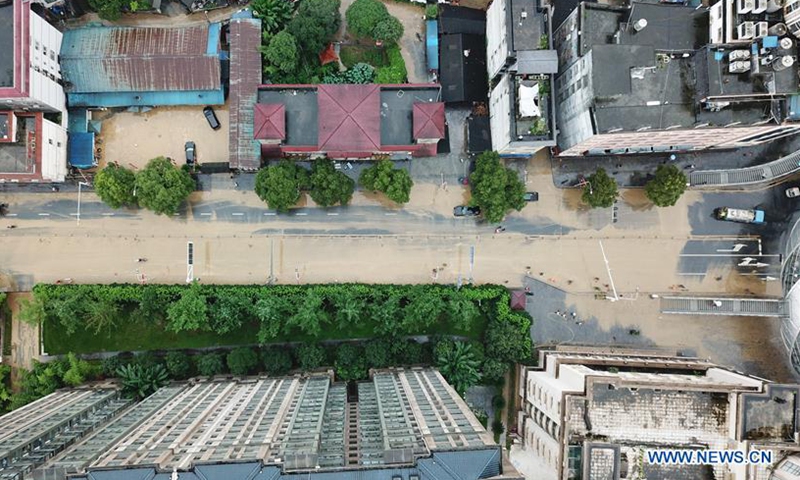
Aerial photo taken on July 8, 2020 shows a flooded road in Jishou City, central China's Hunan Province. Heavy rainfall hit Jishou City of Xiangxi Tujia and Miao Autonomous Prefecture on Wednesday. (Xinhua/Chen Zhenhai)
China is using advanced "black technologies" which include 5G, virtual reality (VR) and artificial intelligence (AI) to combat floods that hit parts of China including East China's Jiangxi Province and Anhui Province.
According to statistics Alibaba sent to the Global Times on Saturday, the e-commerce giant has deployed various technology-backed products to help local governments fight the floods, while the tech company continues to develop flood-fighting technologies.
Alibaba has developed an AI-backed flood-prediction model. Not only can the model make detailed water level predictions based on information such as weather and geology, it can also make real-time simulations of drainage patterns.
The e-commerce giant has also backed the Zhejiang health code, a natural disaster prevention and emergency rescue platform, with AliCloud technologies. The platform sends a red alert, warning users of a pending natural disaster such as floods and typhoons so that they could move to a safer location. Residents can also use the code to access disaster shelters and retrieve relief supplies.
Chinese web mapping provider AutoNavi, or Gaode Map, also launched a disaster shelter map backed by AI technologies for flood-hit Anji county in East China's Zhejiang Province. Users can use online maps to find which of Anji's 225 disaster shelters is closest to their location, media reports said.
In Anqing of Anhui Province, local telecommunications companies are sending real-time water levels to flood monitoring personnel via 5G signals, which can be received by wearing VR glasses, according to a People's Daily report on Thursday.
China has mounted efforts to use high technologies to deal with disasters, including technologies that played a key role in controlling and preventing the spread of the coronavirus. The technologies used to combat the virus include AI-backed auxiliary diagnosis systems, which make rapid identification of the infection and 5G, which backed remote medical consultations.
Such usage not only showed the "applicability" of Chinese cutting-edge technologies, but also manifested the government's inclusive attitude toward the application of high technologies in real scenarios, Liu Dingding, an independent tech analyst in Beijing, told the Global Times. He added that few governments have attached as much importance to technological development as the Chinese government, which has put technology-focused new infrastructure construction at the center of its development strategy.
He also said that although technologies still play auxiliary roles in disaster relief, it is expected that technologies will take on central tasks in the future, with breakthroughs in technologies such as AI robots.
Global Times
